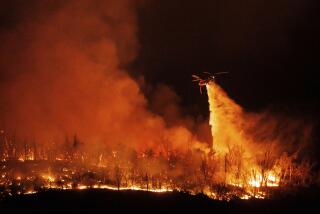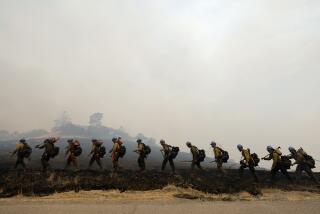Santa Barbara firefighters get a boost from cooler, damp weather
- Share via
SANTA BARBARA — Thousands of Santa Barbara residents were allowed to return home Saturday as morning fog and drizzle gave firefighters the upper hand in their assault on the 5-day-old Jesusita fire, which stretches for five miles.
Erratic winds and high temperatures last week had stoked the blaze and led officials to order the evacuation of 30,500 people in an enormous swath of the city. Officials said about half that number were able to go home.
Firefighters said the fire was about 40% contained and -- with no predictions today for the sundowner winds that had driven embers down the canyons -- could be fully contained by Wednesday.
“The saving grace is lack of wind,” said Tom Franklin, the Santa Barbara County fire chief. “Should the wind shift or weather change, there’s always an opportunity for that fire to take off.”
Firefighters stalled the blaze on the east and west. But they are concerned the northern front will be harder to stop as it moves into rugged terrain, and they plan to keep many of the 4,321 firefighters and equipment operators on the scene.
On Saturday night, authorities offered their most detailed assessment of the devastation: 8,733 acres burned, 31 homes destroyed, 47 others damaged and two outbuildings ruined. The fire has cost $4.3 million to fight.
Two firefighters suffered minor cuts Friday, bringing the total injured to 13. Only two have been seriously injured, and they remain hospitalized at the Grossman Burn Center in Sherman Oaks.
Residents rejoiced, but prayed for the sundowner winds to stay dormant.
“I still have my cat here, my husband and my house,” said Sofia Galina, 70, as she stood in the frontyard of her untouched home on Jesusita Lane, cutting red roses speckled with white ash. “It feels good. I’m glad everything is over.”
The skies above Santa Barbara were clearer, but smoke still billowed from the loftiest peaks.
From Foothill Road the sweeping view of the city’s magnificent backdrop -- the steeply folded Santa Ynez Mountains -- was of a wasteland, singed brown and dusted white.
Pointing to Inspiration Point high on the Jesusita Trail, which gave the fire its name, Jennifer Ellison said, “Now it’s completely burned out, and it’s not inspirational anymore.”
The 46-year-old mortgage broker had been allowed to return to her house on Montrose Place, a street that is lush with bougainvillea, rosebushes, oleanders and pines. The house, near Mission Canyon, survived, but several nearby homes had burned to the ground. In front of one was a soot-covered stuffed elephant.
The brick house across the street, which still stood, hosts the annual block party to raise fire awareness, an event that is not held until June. “I guess we should have had it a little bit earlier this year,” Ellison said.
At roadblocks leading up to still officially closed Mission Canyon, residents negotiated, argued and pleaded with law enforcement officers to let them by to get a glimpse of their homes. Some biked or hiked in.
Cmdr. Darin Fotheringham of the county Sheriff’s Department said officials were “evaluating hour by hour” when the rest of the evacuees could return home. “We do ask for the public’s patience in this endeavor,” he said.
Mike Schlagel, 57, parked his car and took a mountain bike up to property he owns on Montrose Place. He found the main house, which he rents out, intact and a two-car garage he used for an office and storage ruined. Among the treasures he lost -- a chest that held baby pictures of his now-college-age daughter.
He estimated the damage at $50,000 but noted calmly that his “renters will be pleased” the house survived.
In the mountains northeast of Santa Barbara, crews continued to do battle.
Joseph Rubio surveyed a bleak landscape of smoldering hot spots and skeletal manzanita jutting up from gray ash. “Thursday afternoon and night up here was crazy,” he said, shaking his head. “We were cutting fire lines alongside 60-foot flames. Homes were burning up in howling winds. Mules were running around loose.”
Rubio, 50, was one of two dozen inmate volunteers from the Fennel Canyon Conservation Camp near Palmdale. Armed with shovels, cutting tools and all the water they could carry, the crew was among dozens working on narrow ridgelines and almost-vertical slopes to stamp out the last remaining hot spots.
It was hot, sweaty and tedious work. Still, it was “nothing like what we had to deal with a few days ago,” said Capt. Matt Edmiston of the California Department of Forestry and Fire Protection, who was in charge of Rubio’s crew. “We arrived up here at 2 a.m. on Wednesday, and after that it was 50-mile-per-hour sundowner wind conditions and red flag warnings every afternoon.”
Pointing his shovel toward a flare-up, he added: “We’re not out of the woods yet. Not by a long shot.”
Some residents wept with joy and expressed gratitude to the firefighters. Glenn Miller was moved to tears as he reflected on how his home in San Roque Canyon had been saved.
He stayed behind to help firefighters find their way around his 25-acre avocado grove and his system of hydrants. But at 4 a.m. Friday, firefighters told him they would have to leave. Some of the plastic pipes had melted and the water had stopped. Miller packed his cat and pet snake into the car, prepared to go.
But just before the crew left, he reached his ranch manager, who was able to explain to firefighters how to jerry-rig the system. Water flowed, and his house was saved.
“This is home,” he said. “It’s safer now than it’s ever been. When I moved here 14, 15 years ago, we had 50 years of fuel here. Now we have no fuel.”
Others were not so lucky.
Mike Stoltz, 50, a real estate broker, had taken a good look Tuesday morning at the soaring wooden ceilings and glass windows of his home on El Cielito Road before evacuating.
“I had the sense that as I left the grand old house, it might be the last time I saw it,” he said.
His premonition proved correct. He sneaked back to the area a day later. At first he felt hopeful. Neighboring houses looked good. But then he reached his long driveway and started up it. His garage was smoldering. He was studying it when his friend, who had continued to walk toward the house, turned back.
“I heard him say, ‘I’m so very sorry,’ ” recalled Stoltz. “I thought. ‘What does that mean?’ ”
Where his home of 15 years had stood, all Stoltz saw was a wide-open view of the ocean.
By Saturday, he and his partner, Arnie Kassoy -- who had lived in the house for 30 years -- and their two sons had had some time to adjust. “I never really appreciated this house,” Stoltz said. “I always complained about being so far from the ocean. I’m a beach guy. . . . It hit me -- the loss. It was like a member of the family. A pet. It was so tragic.”
E-mails from friends fill his inbox. A cafe in Santa Barbara served him for free Saturday. At Old Navy, where he bought clothes, the store gave him a 10% discount. His cable company told him not to worry about the lost equipment.
“The outpouring of humanity has been so overwhelming and stunning,” he said.
Fred Hendrix, 55, a machinist who lives on Williams Way near Mission Canyon, has made periodic visits to his house since the fire started. On his eerily still street, Hendrix was an odd sight, carrying on as he might have on any typical weekend. He was preparing pots to plant blackberries and boysenberries.
Hendrix grew up in the white house with baby-blue trim and an amazing view of Santa Barbara, and has seen many wildfires in the mountains. But, he said, “this is the nastiest fire I’ve ever seen.”
--
esmeralda.bermudez @latimes.com
Times staff writers Louis Sahagun in Santa Barbara and Jessica Garrison and Carla Hall in Los Angeles contributed to this report.
More to Read
Sign up for Essential California
The most important California stories and recommendations in your inbox every morning.
You may occasionally receive promotional content from the Los Angeles Times.











